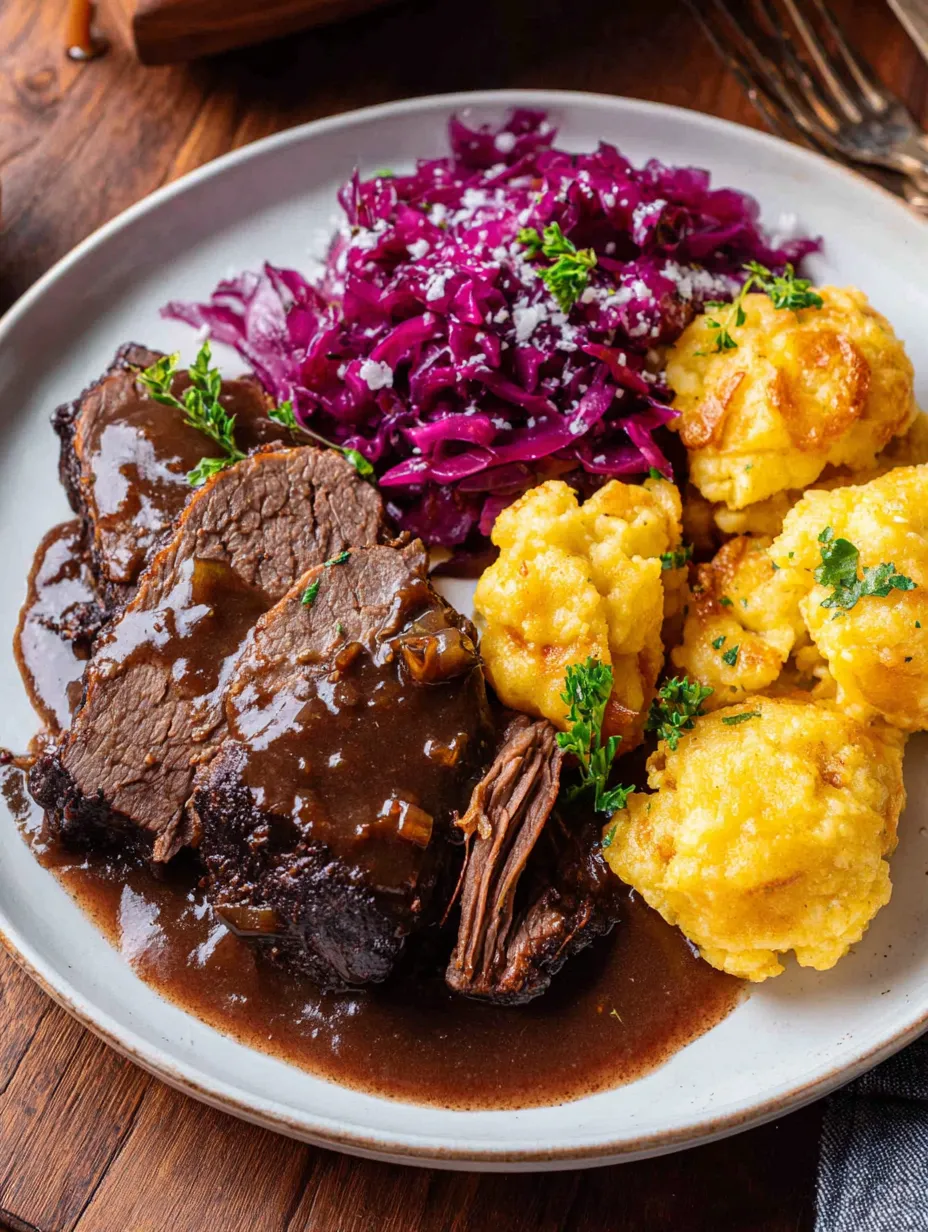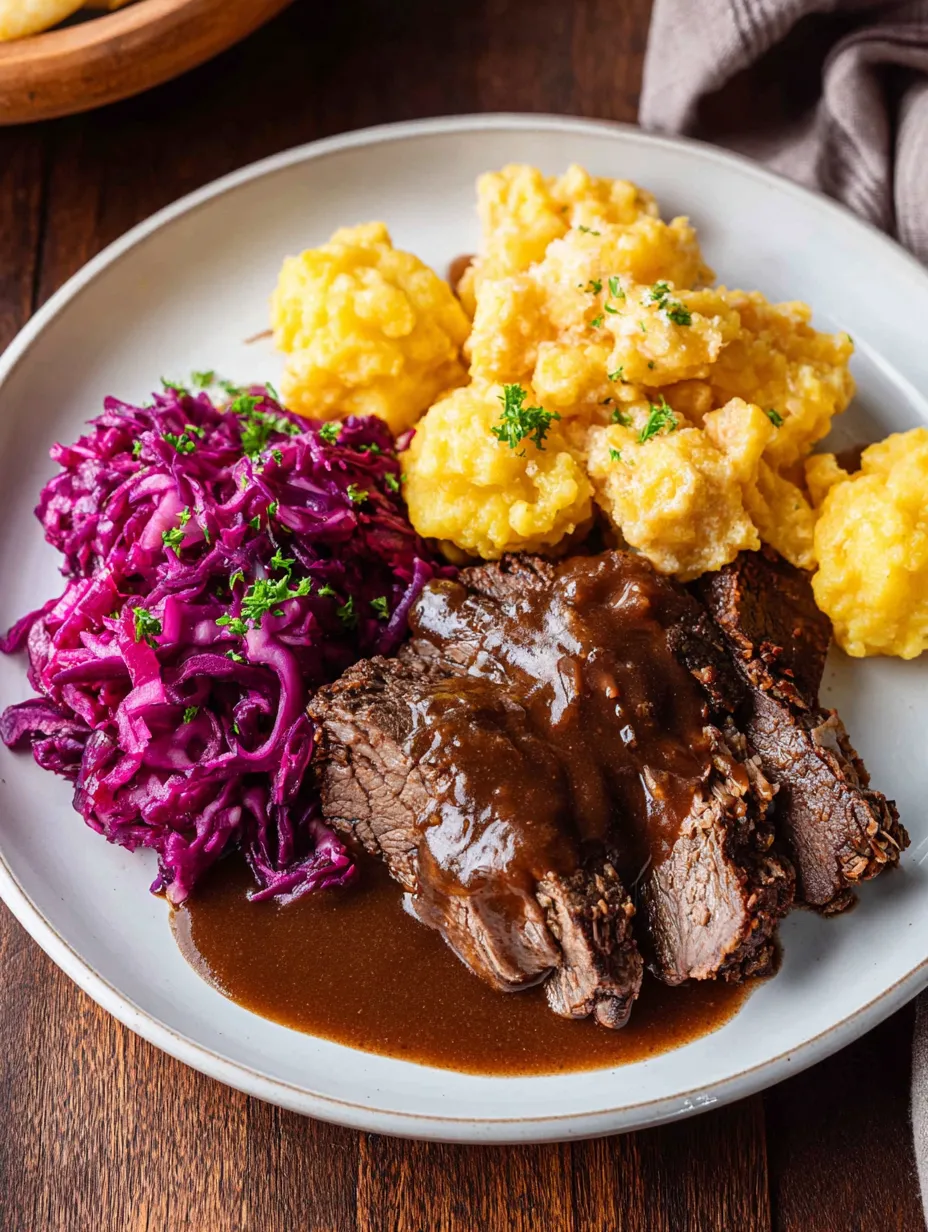 Save
Save
Sauerbraten is the kind of dish that transforms a tough beef roast into the most tender flavorful meal with a tangy sauce made from days of patient marinating. If you want to bring a little bit of old-fashioned German comfort into your kitchen nothing beats the rich aroma that will fill your home as this beloved roast braises away
My first attempt at Sauerbraten was for my German grandmother and you can bet I was nervous It was worth every bit of planning to see her light up at the familiar taste
Ingredients
- Large onion chopped: gives an aromatic foundation for the marinade making the flavor base
- Medium carrots chopped: add natural sweetness and color look for firm deep orange carrots for best flavor
- Large leek chopped: brings a subtle sweetness and rounds out the marinade use fresh crisp leeks and wash thoroughly
- Red wine vinegar: for that essential sour note use a high-quality vinegar for a balanced marinade
- Dry red wine: gives both acidity and richness grab a bottle you would gladly drink with dinner
- Low-sodium beef stock: deepens the savory notes look for stock with natural ingredients
- Granulated sugar: balances the tartness in the marinade
- Golden raisins: provide pops of sweetness seek plump moist raisins for this
- Bay leaves whole: help perfume the entire dish with earthy depth
- Whole juniper berries: deliver classic aromatic bitterness if you cannot find these in your local shop check a spice store
- Whole cloves: create warm undertones and give a spiced background to the dish
- Diamond Crystal Kosher salt: seasons the marinade evenly its flaky texture dissolves well
- Black pepper freshly cracked: adds a subtle bite use fresh ground for best impact
- Rump roast: the traditional beef cut for this dish look for one with marbling for flavor and tenderness
- All-purpose flour: for dredging will help make a beautiful crust on the meat and thicken the gravy
- Salt and pepper to taste: adjust as needed throughout for balanced flavor
- Lard or vegetable oil: to sear the meat lard will yield a classic flavor but a neutral oil works too
- Gingersnap cookies crushed: untraditional yet essential thickening agent for the gravy go for spicy snappy cookies
- Golden raisins optional: can be added at the end for extra bursts of sweetness
Step-by-Step Instructions
- Marinate the Beef:
- Simmer onions carrots and leeks with vinegar wine beef stock sugar raisins bay leaves juniper berries cloves salt and pepper for ten minutes then let cool completely Immerse the roast in this marinade in a deep container making sure it is evenly coated Cover and refrigerate for at least four days turning the meat every twelve hours so every bite is equally flavorful
- Prep for Roasting:
- When your patience is rewarded remove the roast from the marinade and dry all sides thoroughly with clean paper towels Save every drop of the marinade you will need it again Patting the beef dry helps create a better sear
- Sear the Roast:
- Lightly coat the roast with flour and shake off any extra Season the floured beef with a touch more salt and pepper Heat your Dutch oven over medium with lard or vegetable oil Add the roast and brown all sides well about ten to fifteen minutes This caramelization is what builds serious flavor
- Braise Until Tender:
- Pour the reserved marinade back into the Dutch oven with the browned roast Bring it barely to a simmer on the stovetop Cover with a tight-fitting lid and place in a 300 degree oven Cook at least three hours then test for tenderness by sliding a thin knife into the beef There should be almost no resistance If not quite tender cook for up to forty-five minutes more and check again
- Make the Gravy:
- Set the cooked roast aside tented with foil to keep warm Strain the cooking liquid discard the solids and return the sauce to the pot Place over medium heat and whisk in crushed gingersnap cookies and if you like extra raisins Simmer about ten minutes until glossy and thick Taste and adjust seasoning If you prefer an extra thick gravy stir in a little cornstarch slurry
- Slice and Serve:
- Cut the roast against the grain into thin slices Lay on a serving platter and spoon the rich sauce over Top with extra sauce at the table for anyone who wants more

Classic Sauerbraten is not just a meal it is an event in a German household The gingersnap trick for thickening and flavor is my favorite part of this dish as it always surprises guests who cannot guess the secret ingredient My kids now ask for second helpings of the tangy sweet gravy every time
Storage tips
Sauerbraten only gets better after a night in the fridge so do not toss leftovers Store any extra slices and sauce in a tight container for up to three days Reheat gently on the stove or covered in the oven to keep the meat moist and flavorful I have even frozen leftovers in portions which taste almost as good as day one after a gentle thaw
Ingredient substitutions
No rump roast No problem Use chuck roast which will be a bit more shreddy but just as tasty Juniper berries can sometimes be tricky to find so you can skip them or substitute with a small splash of gin to get a hint of that woodsy flavor If you cannot find gingersnaps a handful of crushed spiced cookies or even a swirl of molasses and a pinch of cinnamon work in a pinch
Serving suggestions
Traditionally Sauerbraten is served with hearty sides such as potato dumplings buttered noodles or red cabbage These absorb the tangy rich sauce better than anything For a festive spread I love adding some roasted root vegetables and a big pile of crispy spaetzle

Cultural context
Sauerbraten is often called Germanys national dish and it showcases old world conservation where even tough cuts of beef are turned into something spectacular through time and patience Many German regions have their own twist and the dish is especially popular during winter and family gatherings My own family always serves it around the holidays when we want something that feels like a warm hug from the past
Recipe FAQs
- → What cut of beef works best for this dish?
Rump roast is traditional, but chuck roast is also excellent, providing a tender texture that can be sliced or shredded.
- → How long should the beef marinate?
For robust flavor, marinate the beef at least 4 days, turning every 12 hours. Some enthusiasts marinate for up to a week.
- → Why add gingersnaps to the sauce?
Crushed gingersnap cookies thicken the sauce and give it subtle spice and sweetness, enhancing the gravy’s complexity.
- → How should the beef be prepared before braising?
Pat the beef dry, season, dredge in flour, then brown in a Dutch oven to develop flavor before slow braising in the marinade.
- → Are leftovers easy to reheat?
Yes, leftovers keep well in the fridge for up to 3 days and can be reheated in the oven or microwave for easy serving.
- → Can I use other cuts or substitutions?
While rump roast is classic, chuck works beautifully. Vegetable oil may substitute for lard, and red wine vinegar adds important tang.
